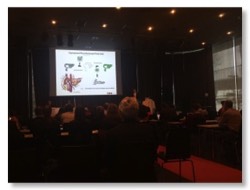Decellularization of pancreata – EPITA Award

Ben Strücker presented three effective protocols for rat pancreas perfusion decellularization, evaluating different perfusion routes. In contrast to liver decellularization the perfusion route seems to have no major impact on decellularization results. The dPECMs could serve for cellular repopulation with islets from a different (xenogene) origin to generate functional, transplantable endocrine pancreata in vitro.

